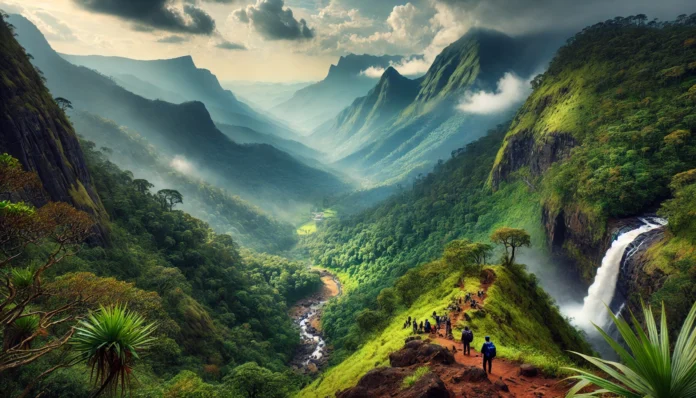The Western Ghats, a UNESCO World Heritage site, stretch over 1,600 kilometers, weaving through the states of Maharashtra, Goa, Karnataka, Kerala, and Tamil Nadu. Known for their breathtaking biodiversity, lush greenery, and mist-covered peaks, the Western Ghats are a trekking paradise for adventure seekers. In this guide, we will explore some of the most mesmerizing trekking routes, essential tips for your journey, and the unique experiences that await those who dare to conquer the clouds.
1. Best Treks in the Western Ghats
The Western Ghats offer a diverse range of trekking trails, each unique in its challenge and beauty. Here are some must-experience treks:
- Kumara Parvatha Trek (Karnataka): One of the most challenging and rewarding treks in Karnataka, this two-day trek takes you through dense forests, waterfalls, and steep climbs, culminating at the peak with panoramic views of the surrounding valleys.
- Chembra Peak Trek (Kerala): Nestled in the Wayanad region, Chembra Peak is one of the highest peaks in the Western Ghats. The heart-shaped lake on the way to the summit is a natural wonder, and the views from the top are spectacular.
- Rajmachi Fort Trek (Maharashtra): A moderate trek that’s rich in history, Rajmachi Fort offers trekkers the chance to explore ancient forts while enjoying views of the Sahyadri mountains and lush green surroundings.
- Tadiandamol Trek (Karnataka): As the highest peak in Coorg, Tadiandamol is a trekker’s delight with its scenic views, verdant forests, and rolling meadows.
Pro Tip: Each of these treks offers a different level of difficulty, so choose one that suits your experience level and fitness.
2. When to Trek in the Western Ghats
The Western Ghats experience a tropical climate, making some seasons more favorable for trekking than others. The ideal time for trekking is during the post-monsoon and winter seasons, between October and February. During this period, the weather is cooler, the skies are clearer, and the monsoon-fed greenery is at its peak.
Note: Monsoon season (June to September) can be risky due to slippery trails and heavy rainfall, but it also offers an unmatched experience of trekking through misty clouds and witnessing gushing waterfalls.
3. What to Pack for a Western Ghats Trek
Packing smartly is key to enjoying your trek in the Western Ghats. Here’s a checklist of essentials:
- Footwear: A sturdy pair of waterproof trekking shoes with good grip is essential, especially if you’re trekking during or after the monsoon season.
- Clothing: Breathable, quick-dry clothes are recommended. Pack layers for colder altitudes.
- Rain Gear: Always carry a rain jacket or poncho, even during non-monsoon months, as the weather in the Ghats can change rapidly.
- First-Aid Kit: Include basics like antiseptic cream, bandages, pain relievers, and any personal medications.
- Water Bottle and Snacks: Keep yourself hydrated and energized with enough water and light snacks like energy bars, fruits, or nuts.
Insider Tip: Carrying a small dry bag for electronics and valuables is helpful, especially in regions prone to sudden rainfall.
4. Unique Experiences While Trekking the Western Ghats
Trekking in the Western Ghats is more than just an adventure – it’s an opportunity to connect with nature and experience the region’s rich cultural and ecological diversity:
- Biodiversity: The Western Ghats are home to over 7,000 species of plants and animals, including endangered species like the Nilgiri Tahr and the Lion-tailed Macaque. Birdwatchers can spot rare species such as the Malabar Pied Hornbill and Great Indian Bustard.
- Waterfalls and Rivers: The monsoons feed numerous waterfalls that cascade through the Ghats. Treks like Dudhsagar Falls Trek offer an up-close view of these majestic water bodies.
- Cultural Encounters: The Ghats are home to many indigenous communities. On treks like the Agumbe Rainforest Trek, you might have the chance to meet locals, learn about their traditions, and even stay in homestays, offering an authentic cultural experience.
Pro Tip: Respect the local culture and environment by following Leave No Trace principles and supporting local economies by opting for homestays and local guides.
5. Safety Tips for Trekking in the Western Ghats
While trekking in the Western Ghats can be an exhilarating experience, safety should always come first. Here are a few essential safety tips:
- Plan your route in advance: Research the trek thoroughly, understand the difficulty level, and plan accordingly.
- Hire a local guide: Many treks in the Western Ghats are remote, and having an experienced guide can help navigate tricky terrains.
- Stay hydrated and pace yourself: The humidity in the Western Ghats can be intense, so take breaks and stay hydrated to avoid exhaustion.
- Check the weather forecast: The weather in the Ghats can change quickly, so always check the forecast before setting out.
Conclusion:
Trekking in the Western Ghats is an unforgettable experience that offers the perfect mix of adventure, scenic beauty, and cultural immersion. Whether you’re a seasoned trekker or a beginner looking to embark on your first trek, the Ghats have something for everyone. From the mist-covered peaks of Chembra to the challenging trails of Kumara Parvatha, each trek offers a unique perspective of this mesmerizing mountain range. So, pack your bags, lace up your boots, and get ready to conquer the clouds!



